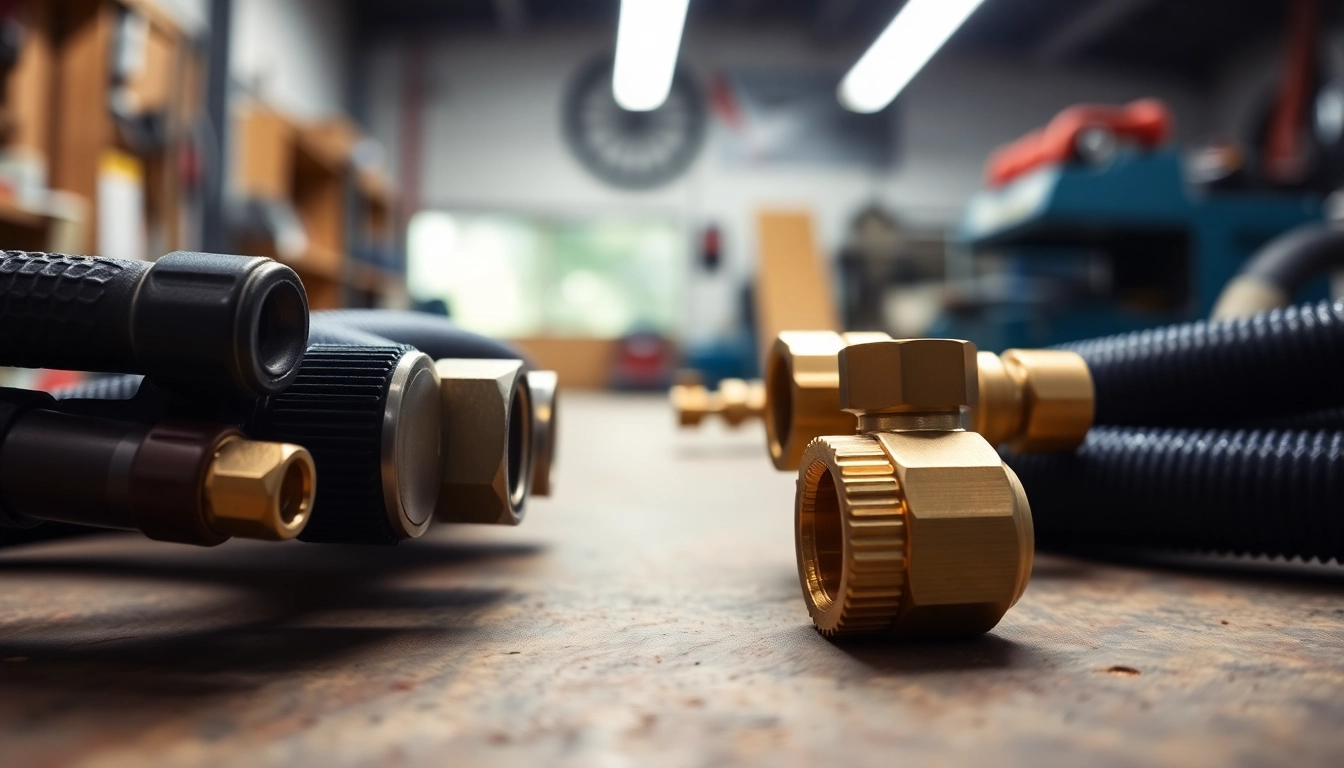Understanding Air Hoses and Fittings
What are Air Hoses and Fittings?
Air hoses and fittings are essential components of pneumatic systems, facilitating the transfer of compressed air from an air compressor to various tools and equipment. Typically made from durable materials, air hoses are designed to withstand high pressure and environmental conditions, while fittings serve as connectors enabling quick, leak-proof connections between hoses and equipment. Together, they optimize the performance of pneumatic tools, ensuring a seamless supply of air wherever it is needed.
In the world of air tools, understanding different types of air hoses and fittings is crucial for anyone looking to maximize efficiency and safety in their operations. This comprehensive guide will delve into the various aspects of air hoses and fittings, providing insights into their types, applications, and maintenance tips.
The Importance of Quality in Air Hoses
When working with compressed air systems, the quality of air hoses and fittings cannot be overstated. High-quality hoses not only ensure safety but also enhance the efficiency of pneumatic tools. Inferior hoses may lead to leaks, reduced airflow, and premature tool wear, resulting in costly repairs and downtime.
Quality hoses possess essential features such as robust construction, resistance to kinking, and the ability to maintain flexibility in varying temperatures. Ensuring that hoses meet industry standards is crucial for safety and performance, as it reduces the likelihood of accidents and improves the overall reliability of air-operated equipment.
Common Applications of Air Hoses and Fittings
Air hoses and fittings find a broad range of applications across various industries. From automotive repair to manufacturing and construction, they play a vital role in facilitating tasks that require compressed air. Common uses include:
- Operating pneumatic tools such as nail guns, impact wrenches, and spray guns.
- Inflating tires and sports equipment.
- Cleaning workspaces with air blowers.
- Powering air-operated machinery in factories.
- Providing air supply for pneumatic systems in HVAC installations.
Types of Air Hoses
Rubber vs. PVC Air Hoses
Two of the most common materials used for air hoses are rubber and PVC, each offering distinct benefits and drawbacks.
Rubber Air Hoses
Rubber air hoses are renowned for their flexibility, durability, and ability to withstand high temperatures. Their intrinsic resistance to kinking and abrasion makes them suitable for heavy-duty applications. However, their weight can be a downside, as they tend to be bulkier compared to other materials, making them less portable.
PVC Air Hoses
PVC air hoses, on the other hand, are lighter and typically more affordable than rubber options. They resist chemicals and are suitable for a variety of conditions. However, PVC hoses may not perform as well in extreme temperatures, becoming stiff and prone to kinks. Therefore, when choosing between rubber and PVC, the specific application and environmental conditions must be considered.
Polyurethane Air Hoses: Pros and Cons
Polyurethane air hoses are gaining popularity due to their lightweight and flexible nature. They are resistant to abrasions, chemicals, and UV rays, making them ideal for outdoor use. However, polyurethane hoses can be more susceptible to kinking than rubber hoses, which could affect airflow.
When selecting a polyurethane hose, it’s essential to consider its intended use. They work well for light to medium-duty applications, such as tools used in automotive and woodworking projects.
Choosing the Right Hose for Your Tools
Choosing the appropriate air hose for your tools involves several factors, including length, diameter, and material. The length of the hose should provide enough reach without being excessively long, which can cause pressure drop. Additionally, the interior diameter (ID) of the hose should match the requirements of the tools being used to ensure optimal air flow and tool performance.
Moreover, consider the operating pressure of your tools and select hoses that can withstand higher pressures to avoid bursting. Understanding these factors can help users make informed decisions on hoses that meet their functional and performance needs.
Types of Air Fittings and Couplers
Quick Connect vs. Threaded Fittings
Fittings are essential for connecting hoses to tools and compressors, and they generally fall into two categories: quick connect and threaded fittings.
Quick Connect Fittings
Quick connect fittings allow for fast and effortless connection and disconnection of hoses and tools without requiring additional tools. They are ideal for applications where hoses need to be frequently swapped or removed. Quick disconnect fittings come in various sizes and shapes, ensuring a secure connection that minimizes leaks.
Threaded Fittings
In contrast, threaded fittings offer a more permanent solution. They screw into place, providing a strong and reliable connection suited for applications where hoses remain stationary. While slower to connect and disconnect, threaded fittings are less likely to come loose during use.
Choosing the Right Fitting Size
Getting the right size fitting is crucial to maintaining optimal pressure and airflow in your system. A good rule of thumb is to measure the outside diameter of male threads and subtract ¼ inch to determine the nominal size. It’s also vital to note that if the fitting is a quick disconnect type, it will be sized according to the nominal body size rather than the threads.
Material Options for Durability
Fittings are made from various materials, including brass, aluminum, and plastic. While brass fittings are robust and resistant to corrosion, aluminum options are lightweight and suitable for lower-pressure applications. Plastic fittings are generally the most affordable but may not withstand high pressure or extreme temperatures as well as metal alternatives.
Installation and Maintenance Tips
How to Properly Connect Air Hoses and Fittings
To ensure a leak-proof connection when installing air hoses and fittings, follow these steps:
- Inspect both the hose and fittings for any damage or debris before connecting.
- Align the hose and fitting to ensure compatibility and a tight fit.
- Use appropriate tools for threaded fittings, ensuring they are secured without overtightening.
- For quick connect fittings, push the hose into the fitting until you hear a click indicating a secure connection.
Routine Maintenance for Longevity
Maintaining air hoses and fittings is vital for optimizing performance and longevity. Regularly checking for wear, leaks, and cracks can prevent costly repairs. It’s advisable to clean fittings and connections to remove dust or build-up that may impact airflow. Additionally, proper storage of hoses, avoiding excessive bending or twisting, will extend their lifespan.
Common Issues and Troubleshooting
Multiple issues can arise with air hoses and fittings, but many can be mitigated with proactive measures. Common problems include:
- Leaks: Often caused by worn seals or improper fitting installation. Identifying the source and replacing damaged components can resolve this issue.
- Kinking: This often affects the airflow. Using properly rated hoses for your application helps minimize this risk.
- Pressure drop: Caused by using oversized or undersized hoses or fittings. Ensuring compatibility between components can help maintain optimal pressure.
Conclusion: Maximizing Your Setup
Final Thoughts on Air Hoses and Fittings
Air hoses and fittings play a vital role in the efficiency and safety of pneumatic systems. Understanding the various options available, from hoses made of different materials to the types of fittings, enables users to make informed decisions that can improve both performance and longevity. Careful consideration of the requirements of your tools will guide you toward the best setup for your needs.
Where to Purchase Quality Products
Investing in high-quality hoses and fittings is imperative for optimal performance. Reliable suppliers such as air hoses and fittings providers can ensure that you obtain products that meet industry standards and specifications.
Resources for Further Reading
For those looking to deepen their understanding of air hoses and fittings, consider exploring the following resources:
- Air Hose Buyer’s Guide from Rolair Systems
- PVC vs. Rubber Air Hose: The Difference Explained
- Identifying the Right Air Hose Fittings



